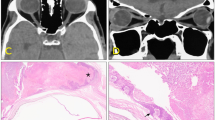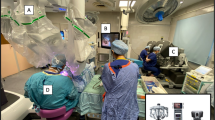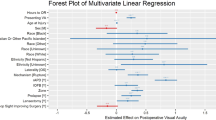Abstract
Objective
This study aimed to evaluate the risk factors of postoperative severe vision impairment (PSVI) for a primary orbital tumour in the muscle cone.
Methods
A retrospective analysis of the patients who underwent orbitotomy for primary intraconal tumours at the Tianjin Medical University Eye Hospital from January 2010 to December 2015.
Results
A total of 165 cases of orbitotomy for primary orbital tumours in the muscle cone were included in the study. Postoperatively, 12 cases with vision acuity ≤20/400 or ≥4 rows of vision decline and without any corrected effect were analysed as PSVI, including no light perception (NLP) for 3 cases. The multivariate logistic regression indicated that the tumour in orbital apex (P = 0.048, OR = 4.912, 95% CI: 1.011–23.866), severe optic nerve displacement (P = 0.030, OR = 6.007, 95% CI: 1.184–30.473) and intraoperative tight adhesion (P = 0.003, OR = 12.031, 95% CI: 2.282–63.441) were the independent risk factors for PSVI.
Conclusions
The incidence of PSVI for the intraconal tumour was 7.3%, and the incidence of NLP was 1.8%. The tumour in orbital apex, severe optic nerve displacement and intraoperative tight adhesion were independent risk factors for PSVI.
Similar content being viewed by others
Log in or create a free account to read this content
Gain free access to this article, as well as selected content from this journal and more on nature.com
or
References
Gosau M, Schoneich M, Draenert FG, Ettl T, Driemel O, Reichert TE. Retrospective analysis of orbital floor fractures-complications, outcome, and review of literature. Clin Oral Investig. 2011;15:305–13.
Bonavolonta G. Postoperative blindness following orbital surgery. Orbit. 2005;24:195–200.
Purgason PA, Hornblass A. Complications of surgery for orbital tumors. Ophthalmic Plast Reconstr Surg. 1992;8:88–93.
Jacobs SM, McInnis CP, Kapeles M, Chang SH. Incidence, risk factors, and management of blindness after orbital surgery. Ophthalmology. 2018;125:1100–8.
Rose GE. The “devil’s touch”; visual loss and orbital surgery. A synopsis of the Mustarde Lecture, 2006. Orbit. 2007;26:147–58.
Kansakar P, Sundar G. Vision loss associated with orbital surgery—a major review. Orbit. 2020;39:197–208.
Tian YM, Xiao LH, Gao XW. Adhesion of cavernous hemangioma in the orbit revealed by CT and MRI: analysis of 97 cases. Int J Ophthalmol. 2011;4:195–8.
Selva D, Strianese D, Bonavolonta G, Rootman J. Orbital venous-lymphatic malformations (lymphangiomas) mimicking cavernous hemangiomas. Am J Ophthalmol. 2001;131:364–70.
Jakobiec FA, Zakka FR, Papakostas TD, Fay A. Angiomyofibroma of the orbit: a hybrid of vascular leiomyoma and cavernous hemangioma. Ophthalmic Plast Reconstr Surg. 2012;28:438–45.
Cho KJ, Paik JS, Yang SW. Surgical outcomes of transconjunctival anterior orbitotomy for intraconal orbital cavernous hemangioma. Korean J Ophthalmol. 2010;24:274–8.
Kim JW, Yates BS, Goldberg RA. Total lateral orbitotomy. Orbit. 2009;28:320–7.
Goldberg RA, Shorr N, Arnold AC, Garcia GH. Deep transorbital approach to the apex and cavernous sinus. Ophthalmic Plast Reconstr Surg. 1998;14:336–41.
Jian T, Sun F, Tang D, Wang S, Wu T, Zhao L. Clinical analysis of transcranial orbitotomy approach on cranio-orbital tumors. J Craniofac Surg. 2015;26:441–6.
Montano N, Lauretti L, D’Alessandris QG, Rigante M, Pignotti F, Olivi A, et al. Orbital tumors: report of 70 surgically treated cases. World Neurosurg. 2018;119:e449–58.
Chhabra N, Wu AW, Fay A, Metson R. Endoscopic resection of orbital hemangiomas. Int Forum Allergy Rhinol. 2014;4:251–5.
Sakata K, Takeshige N, Nagata Y, Yoshitake H, Komaki S, Miyagi N, et al. Endoscopic endonasal removal of primary/recurrent meningiomas in the medial optic canal: surgical technique and long-term visual outcome. Oper Neurosurg. 2019;17:470–80.
Calandriello L, Grimaldi G, Petrone G, Rigante M, Petroni S, Riso M, et al. Cavernous venous malformation (cavernous hemangioma) of the orbit: current concepts and a review of the literature. Surv Ophthalmol. 2017;62:393–403.
Rajabi MT, Naderan M, Mohammadi SZ, Rajabi MB. Central retinal artery occlusion following orbital tumor resection: Is rapid intervention effective? Indian J Ophthalmol. 2015;63:678–80.
Mehta JS, Gajdatsy A, Webster AR, Rose GE. Severe, unstable migraine: a risk factor for postoperative ophthalmic artery spasm? Orbit. 2006;25:65–7.
Ganguly A, Pappuru RR, Ali MJ, Mishra DK, Naik MN. Ophthalmic artery occlusion following transconjunctival orbitotomy. Ophthalmic Plast Reconstr Surg. 2017;33:S171–3.
Maurer P, Conrad-Hengerer I, Hollstein S, Mizziani T, Hoffmann E, Hengerer F. Orbital haemorrhage associated with orbital fractures in geriatric patients on antiplatelet or anticoagulant therapy. Int J Oral Maxillofac Surg. 2013;42:1510–4.
Zimmerer R, Schattmann K, Essig H, Jehn P, Metzger M, Kokemuller H, et al. Efficacy of transcutaneous transseptal orbital decompression in treating acute retrobulbar hemorrhage and a literature review. Craniomaxillofac Trauma Reconstr. 2014;7:17–26.
Acknowledgements
We would like to thank Professor Guoxiang Song and Dr. Song Wang for their advice, as well as Wanchen Yang, M.S. for the data analysis for this manuscript.
Funding
This study was supported by the Tianjin Clinical Key Discipline Project, grant number: TJLCZDXKQ020 and Tianjin Medical University Eye Institute Clinical Research Fund, grant number: 16YKYJS001. The funders had the opportunity to review the final version of the manuscript to address any factual inaccuracies or request the revision of information deemed to be proprietary or confidential and ensure that study support was disclosed.
Author information
Authors and Affiliations
Corresponding author
Ethics declarations
Conflict of interest
The authors declare that they have no conflict of interest.
Additional information
Publisher’s note Springer Nature remains neutral with regard to jurisdictional claims in published maps and institutional affiliations.
Rights and permissions
About this article
Cite this article
Jian, T., Sun, F., Wu, T. et al. Postoperative severe visual impairment: surgical outcome of 165 patients with orbital tumours in the muscle cone. Eye 35, 2535–2542 (2021). https://doi.org/10.1038/s41433-020-01270-7
Received:
Revised:
Accepted:
Published:
Issue date:
DOI: https://doi.org/10.1038/s41433-020-01270-7



